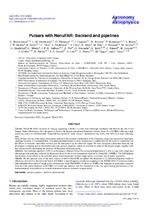Pulsars with NenuFAR: Backend and pipelines
Abstract
Context. NenuFAR (New extension in Nançay upgrading LOFAR) is a new radio telescope developed and built on the site of the Nançay Radio Observatory. It is designed to observe the largely unexplored frequency window from 10 to 85 MHz, offering a high sensitivity across its full bandwidth. NenuFAR has started its “early science” operation in July 2019, with 58% of its final collecting area.
Aims. Pulsars are one of the major phenomena utilized in the scientific exploitation of this frequency range and represent an important challenge in terms of instrumentation. Designing instrumentation at these frequencies is complicated by the need to compensate for the effects of both the interstellar medium and the ionosphere on the observed signal. We have designed a dedicated backend and developed a complete pulsar observation and data analysis pipeline, which we describe in detail in the present paper, together with first science results illustrating the diversity of the pulsar observing modes.
Methods. Our real-time pipeline LUPPI (Low frequency Ultimate Pulsar Processing Instrumentation) is able to cope with a high data rate and provide real-time coherent de-dispersion down to the lowest frequencies reached by NenuFAR (10 MHz). The full backend functionality is described, as the available pulsar observing modes (folded, single-pulse, waveform, and dynamic spectrum).
Results. We also present some of the early science results of NenuFAR on pulsars: the detection of 12 millisecond pulsars (eight of which are detected for the first time below 100 MHz); a high-frequency resolution mapping of the PSR B1919+21 emission profile and a detailed observation of single-pulse substructures from PSR B0809+74 down to 16 MHz; the high rate of giant-pulse emission from the Crab pulsar detected at 68.7 MHz (43 events per minute); and the illustration of the very good timing performance of the instrumentation, which allows us to study dispersion measure variations in great detail.

